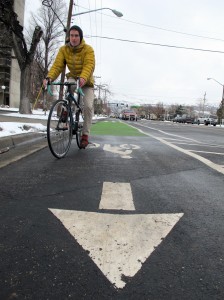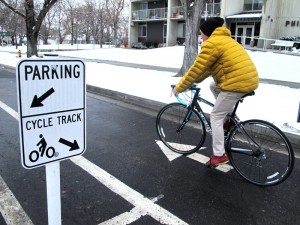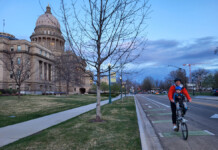
are separated from traffic by a row of parked cars.
Photos: Katie Harrington
By Katie Harrington
Cities all over the country are adopting a new kind of bike lane: one that allows bicyclists to ride on a path located between the curb and a physical buffer – like parked cars or potted plants – so that cyclists are protected from moving traffic.
Last summer, Salt Lake City’s Transportation Division launched a three-block prototype on 300 East (between 600 South and 900 South) that features the protected bike lane – called a cycle track (or separated bikeways) – on two of the blocks, and a more traditional, but extra-wide bike lane on the remaining block.
Becka Roolf, the Bicycle and Pedestrian Coordinator for Salt Lake City, said that the intention in creating the prototype in Salt Lake City is largely to get feedback on the two designs from motorists, bicyclists, and those who live and work along 300 East.
The Green Lanes Project
The three-block prototype was submitted by Salt Lake City to the Green Lane Project for a possible grant – an initiative funded by the Bikes Belong Foundation – whose main goal is to work with cities that already have thoughtful bicycling plans in place, and help them accelerate their ideas through infrastructure. Even though Salt Lake City did not receive the grant, the prototype was built anyway.
“I think of it like this: What would my mom ride? What would she feel comfortable enough riding on: a 65-year-old woman with a bag of groceries?” Zach Vanderkooy said, the International Programs Director for the Green Lanes Project.
“If it’s good enough for her, then it’s good enough. But if it’s not, well then, it’s really not good enough,” he said.
Countries like Denmark and the Netherlands have been utilizing this type of bike infrastructure since the 1970s, but the Green Lane Project has been the driving force behind bringing protected bikes lanes to the United States.
“Our streets are different, our culture is different, and our budgets are different,” Vanderkooy said. “In Denmark and the Netherlands, half of the people moving around are on bikes, and they are doing it safely, comfortably, and easily. We’ve looked at the success of protected bike lanes in Europe, and now we’re helping U.S. cities translate that.”
The Green Lane Project is focusing on infrastructure and bicycling research in six U.S. cities specifically – Chicago, Memphis, San Francisco, Washington, D.C., Austin, Texas, and Portland, Oregon – but positive results have been seen all over the country.

The Results
In New York City, for example, protected bike lanes have had a significant impact on the strength of local businesses.
After the construction of a protected bike lane on 9th Avenue, local businesses were met with a 49 percent increase in retail sales compared to local businesses throughout Manhattan, who only saw a 3 percent increase, according to the city’s Department of Transportation.
In the last decade, the increase of bike infrastructure in Portland has also increased bike commuting in the city by 233 percent, according to John Burke, the president of Trek Bicycle Corporation and a board member of Bikes Belong.
“All test to the theory that if you build it, they will come,” Burke said at Interbike, a bike industry conference, in 2012.
Chicago’s first protected bike lane increased ridership by 55 percent – with little to no effect on travel times of automobiles – according to Chicago’s Department of Transportation.
And a 2012 study published in the “American Journal of Public Health” found that the risk of injury is 89 percent lower while bicycling on protected bike lanes compared to bicycling on major streets with no bike infrastructure.
Alex Dickinson, a senior at the University of Portland, rides his bike on the city’s Bike Corridor daily – infrastructure that the Green Lanes Project helped put into place.
“The worst case scenario is a street without a bike lane,” Dickinson said. “I have been hit twice in Portland and both times it was on streets with no bike lane.”
“But any of those streets where funding has been fueled into making a safer bike lane, I don’t think I could ever be hit really,” he said. “It would be an extreme circumstance for that to happen.”
Utah’s Plans
The results of protected bikeway infrastructure in these Green Lanes Project cities are guiding other places around the country – like Salt Lake City and Ogden – to consider implementing or expanding their own protected bikeway networks that would link to bike paths already in place.
Josh Jones, the Senior Project Coordinator for Ogden City, said they are studying Grant Avenue for cycle track infrastructure that would run from the river to downtown.
“No plans are certain, but we would certainly like to see Ogden have this type of infrastructure,” Jones said.
Salt Lake City’s Transportation Division is releasing a Bicycling and Pedestrian Master Plan revision this year, which will focus on incorporating a low-stress bikeway network that connects various city neighborhoods to downtown.
The purpose of the revisions is to evolve the city’s current Master Plan so that it reflects the best and most relevant practices seen in other U.S. and international cities to date, the Transportation Division said in August. No changes have been made since 2004.
The new revision will likely involve protected bike lanes, given that the community’s response to the cycle track prototype on 300 East has been overwhelmingly positive, said Art Raymond, the Director of Communications at Mayor Ralph Becker’s office.
“[The cycle track] is an arrangement that does not work on all city streets,” Raymond said. “There are many city streets that are too narrow or have too busy a traffic pattern for a cycle track to be practical, but there are certainly many streets where there is potential.”
“We will certainly be looking for future opportunities to use that arrangement further in Salt Lake City,” he said.
Last July, Mayor Ralph Becker’s office requested consulting services for assistance with the Master Plan update, part of which included several proposed cycle track and buffered bike lane plans throughout the city.
Potential cycle track locations are on 300 South between 300 West and the University of Utah; on 700 South between Main Street and 600 East; on 200 East between 200 South and 800 South; on 200 West between North Temple and 700 South; and on 100 South between 600 West and 200 West.
Both Mayor Ralph Becker and the City Council are always looking to improve a wide range of travel options in Salt Lake City, which is part of a longstanding “Complete Streets” philosophy.
In 2010, the City Council passed the Complete Streets Ordinance, which ensures that new street projects or street renovations are being built or modified to most effectively accommodate automobiles, cyclists, pedestrians, and public transit options.
The 9th and 9th renovation was one of those projects. A lane reduction was created so that cyclists could more safely bike through that area.
Design and budgetary logistics are still being discussed in Ogden, but Jones said he would really like to see a cycle track implemented.
Mayor Ralph Becker and the city’s Transportation Division have been looking at the rest of the country for ideas about how to improve the current Master Plan.
“Portland, of course, is another city with cycle tracks, and is one among many cities we look to for great, new ideas,” Raymond said.
In Portland, the bike culture came before the road projects, Dickinson said.
“People saw there was a need for the road projects because there was a growing bike culture. I think there’s a basic bike culture in Salt Lake City, but it’s being stunted by the fact that it’s harder to ride a bike there.”
“Salt Lake’s bike culture really needs these road projects,” he said.
But the city’s bicycling infrastructure plans won’t be known for sure until the publication of the new Master Plan.
Public open houses and community engagement will begin in early March, which will be an important step toward creating the Master Plan, Raymond said.
The final plan is scheduled for release sometime in 2013, Raymond said.
“While we need to continue to accommodate cars, we are always in the pursuit of how to make the other transportation options as viable as they can be,” he said.
To find out more information about the city’s bike plans, visit www.bikeslc.com.
For more information about cycle tracks – sometimes referred to as green lanes in other cities – visit http://greenlaneproject.org/.
Katie Harrington on Google Plus








